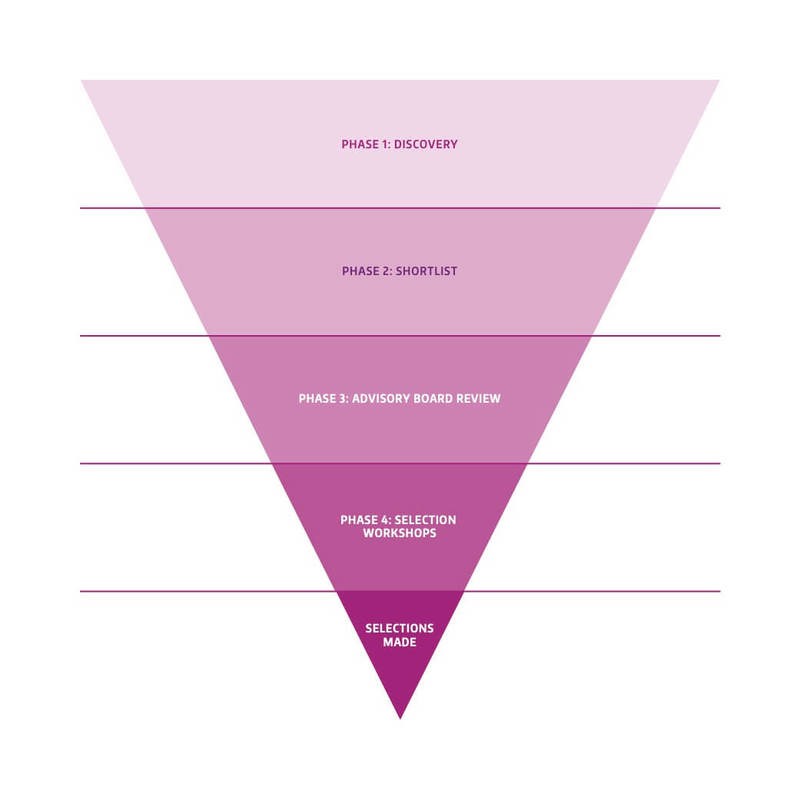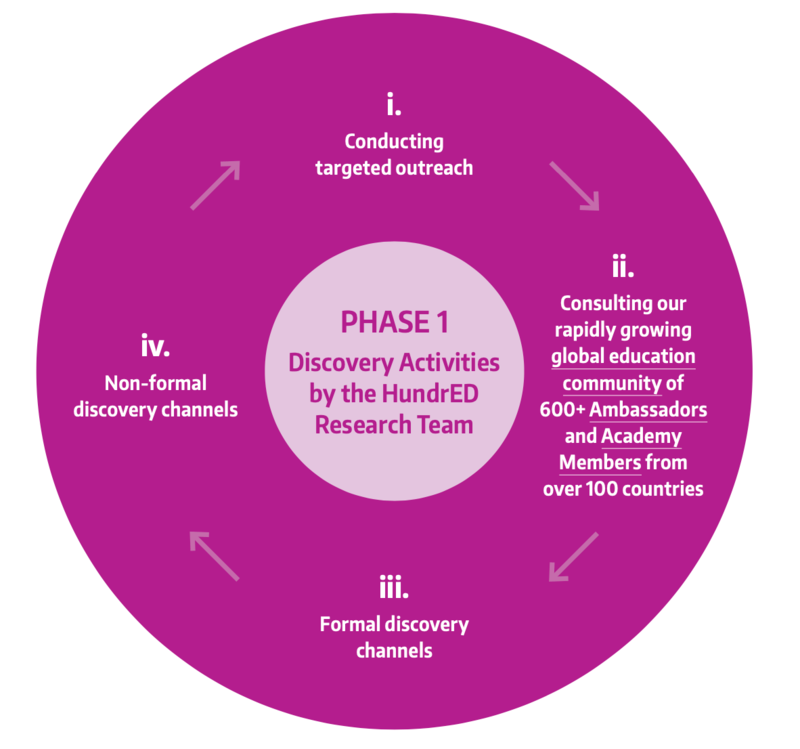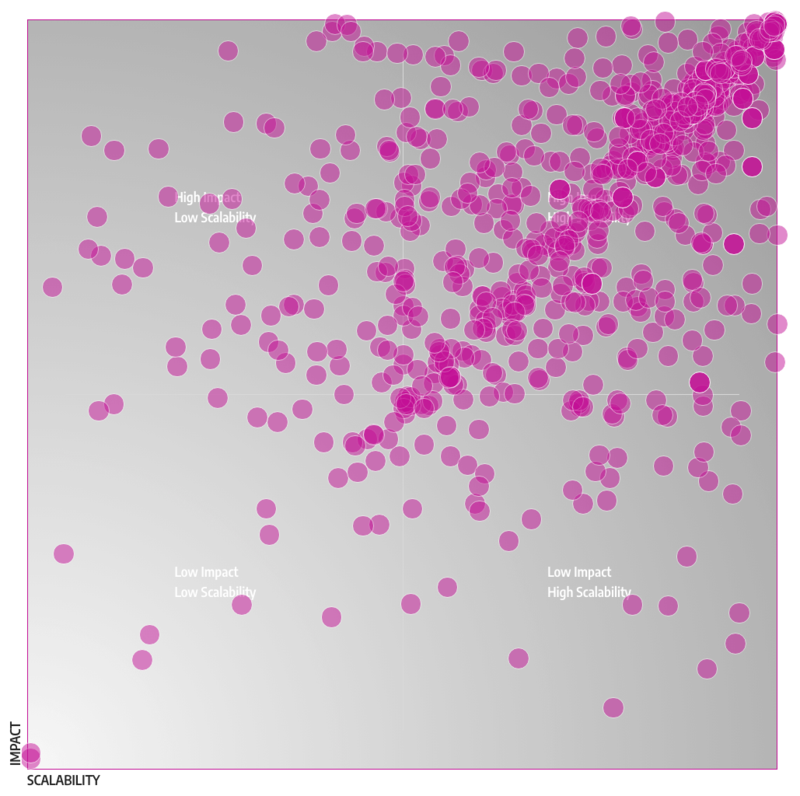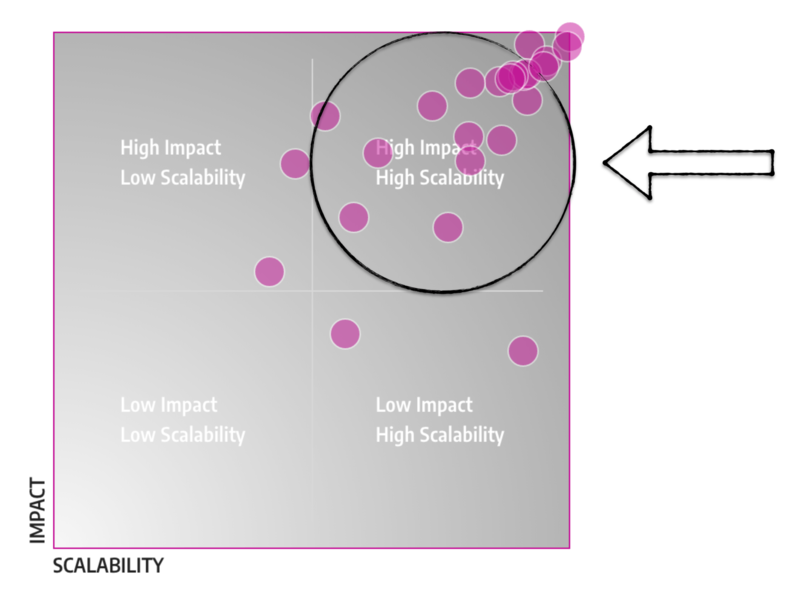At HundrED, we identify impactful education innovations* and help them spread. In this article, a brief overview of our research process for our Global Collections and Spotlights is presented. A more detailed description can be found in our reports, which are freely available to download on HundrED.org here. If you have any further questions, please do not hesitate to reach out to HundrED’s Research Team.
As the figure below indicates, our selection process can be distilled into 4 distinct phases:

To progress through each phase, all innovations must have shown evidence for impact and scalability by the reviewers using the following definitions:
Impact: Evaluated as a valuable improvement within the innovation’s context. All innovations must have at-least 1-year of being implemented with its intended users.
Scalability: Either the innovation is actively expanding to other contexts or has a high degree of transferability for others to adopt its practice/technology.
PHASE 1: DISCOVERY
In the first phase, the HundrED Research Team strives to find the leading impactful and scalable innovations in education across the whole spectrum of school education. We bucket these innovations into five main categories: skills, teacher development, leadership, assessment, and environments.
A key part of the first Discovery Phase is getting help from the HundrED Community, who guide us by being our local eyes and ears about what is happening on the ground in their region. The HundrED Community consists of over 1000 Ambassadors from over 100 countries, and counting.
The main areas of activity by HundrED's Research Team are outlined in the Figure below:

i. Conducting targeted outreach and applicant support to potential submissions
ii. Talking to our growing global education community of 1000+Ambassadors (teachers, leaders, academics, and more) and Youth Ambassadors (current students) all from 100+ countries. These people are essential as our local eyes and ears on the ground - especially in locations that are difficult to get access to (e.g. rural schools and regions with limited internet). They also recommend and report on the best practices and technologies emerging from their region.
iii & iv. Formal and non-formal discovery channels, such as:
- attending major education events and conferences
- monitoring high-profile innovation competitions from around the world
- speaking with experts in and out of education
- studying academic and non-academic texts such as peer-reviewed journals and blogs
- news and books that highlight innovation in education.
PHASE 2: SHORTLIST
In the second phase, HundrED’s Research Team thoroughly reviews each submitted innovation to create a shortlist in preparation for Phase 3. To be shortlisted for our Global Collection and Spotlight projects, each innovation must demonstrate a high quality of evidence for our two criteria of impact and scalability described above.
Before Phase 3 starts, the shortlisted innovations are notified that they will be under review. Innovation teams are given an opportunity to provide any additional material that could help the reviewers to evaluate their impact and scalability in their context. These materials could include in-house and independent research and impact reports, articles, videos, and other material not normally accessible or posted online. The HundrED Research Team review and prepares all materials for accuracy while making sure there is sufficient information for outside experts to make an informed evaluation of the innovation in the next phase.
PHASE 3: REVIEW FROM OUTSIDE EXPERTS
We believe that a diversity of experienced perspectives from a wide range of contexts is fundamentally important to our selection process. There are two kinds of groups that help with our projects:
- The Academy consists of 150 outside experts from 50 countries in education who review our annual Global Collections.
- Advisory Boards are selected for their expertise on our Spotlight projects (e.g. Creativity or Sustainability).
These experts come from around the world and include current academics, innovators, teachers, students, and leaders in education. We strive for the group to represent a balance of perspectives between a wide range of expertise, backgrounds, and contexts. They review the shortlist of innovations curated in Phase 2 over a two-week period.
The Academy or Advisory Board are instructed to primarily consider whether each shortlisted innovation could be impactful and scalable in their context. They do this by reviewing the materials gathered in phase 2 as well as any information they can find about the shortlisted innovations through their own investigation, along with a link to each HundrED innovation page.
From these many perspectives, we at HundrED are able to gain insight as to whether an innovation is considered highly impactful and scalable in multiple contexts. For example, there were over 3400 reviews made by the Academy Members for the 2021 Global Collection. Each plot on these graphs represents a review of an innovation by a HundrED Academy Member.

Each reviewer uses HundrED’s evaluation tool to plot innovations based on the criteria of impact and scalability. We are looking for innovations that the majority of the reviewers evaluate to be in the top right-hand quadrant of high impact and scalability as the figure below indicates.

They then recommend if the innovation should be selected with Yes, No, or Maybe. Finally, specific comments and recommendations for each innovation are made to explain the primary reasons why each reviewer recommends or not recommends an innovation be selected.
PHASE 4: SELECTION WORKSHOPS
In phase 4, all reviews made in Phase 3 are evaluated iteratively in a series of structured workshops with the HundrED Research Team. All reviewed innovations are first ranked from most favourable responses to the least. Highly critical comments are then seriously evaluated to decide whether the innovation should be excluded from the selection process. For example, if a reviewer found insightful research that suggested the innovation’s approach was highly ineffective for the intended context, we would consider excluding it; if necessary, we will contact the innovator and try to find more information.
The final selections are made aiming to balance contexts and themes. We strive to achieve representation from each continent, world bank income group, and current themes of major needs in education today (e.g. education around fake news, sustainability, and challenges brought about by COVID-19).
If you are involved with one of the innovations that are selected, we will notify you shortly after the selections have been made. We will also request a call with your team where we will discuss opportunities and potential ways we can help you. You will also be invited to our exclusive community for selected innovators, where you can connect and share learnings with each other. There are many benefits to being involved in this community, where we aim to help you increase your impact and reach. Details of how we help you can be found on our innovator community page on HundrED.org.
And that is a brief overview of our research process at HundrED. Again, if you have any questions about any of this, please do not hesitate to reach out to us.
*Note: So what exactly do we mean by innovation in education at HundrED?
Inspired by Everett M. Rogers' classic book Diffusion of Innovations (2003), we use the following definition for innovation in education:
“Innovation in education can be defined as meaningful improvements considered within the place of implementation to a new or modified practice and/or technology that supports any part of the educational ecosystem.”
This means innovations must have evidence of improvement over and above what already exists for the intended users. That improvement should also be transferable to multiple contexts.
